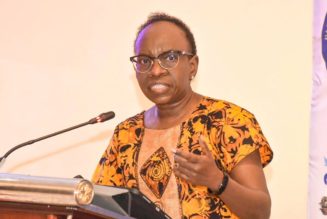
Capital Markets Authority (CMA) Chief Executive Officer Wycliffe Shamiah. PHOTO | DIANA NGILA | NMG
The Treasury has raised the compensation paid to investors who lose money when a brokerage collapses by four times in a strategy aimed at boosting confidence in the stock market.
In changes to regulations on the Capital Markets, Treasury Cabinet Secretary Njuguna Ndung’u said investors who lose money in a collapsed brokerage are now entitled to a maximum compensation of Sh200,000 up from Sh50,000 previously—an equivalent of a 300 percent jump.
“Regulation 70 of the Capital Markets (Licencing requirements) (General) Regulations, 2022, hereinafter referred to as the “principal Regulations”, is amended in paragraph (1) by deleting the word “fifty” and substituting therefor the words “two hundred,” he said in a legal notice.
In a further move aimed at boosting the financial health of stock brokerage firms, the Treasury has raised the minimum share capital requirement for brokers to Sh60 million, up from Sh50 million.
Read: Stockbrokers fight for survival after latest profits plunge
“The second Schedule to the principal Regulations is amended in Part III by deleting the expression “50 million” appearing in paragraph (e) and substituting therefor the expression “60 million”,” Prof Ndung’u said.
Confidence in the stock market took a hit about 15 years ago following back–to–back collapse of three key stock brokerage firms. Francis Thuo and Partners went under in early 2007, marking the first of a series of stockbroker failures that were largely blamed on weak management and fraudulent selling of investors’ shares by the intermediaries.
Nyaga Stockbrokers faced the same fate in 2008, followed by Discount Securities in 2009, and in 2010 Ngenye was put under forced management.
The Capital Markets Authority(CMA) however later lifted Ngenye’s statutory management order, raising hope of Kenya’s first revival of a financially troubled broker.
The regulator and the National Treasury have this year rolled out a series of changes that are anticipated to spur fresh interest in the Nairobi Securities Exchange(NSE) bourse that registered a frenzy by both small and big investors during the late President Mwai Kibaki’s regime.
The State has deployed a raft of strategies including deep cuts in corporate debt transaction fees to relaxing rules on Initial Public Offerings(IPOs) with President William Ruto also promising to have up to State-owned firms listed on the bourse within a year— all signs that the government is desperate to revive action on the regional largest stock market.
The NSE has not had an IPO since 2015 when property investment fund ILAM Fahari I-Reit was listed on the NSE after raising Sh3.6 billion.
As part of these reforms, the Treasury has already slashed the total fees payable by an investor for corporate debt in the secondary market by 10 percent as part of a strategy to spur activity in the segment.
In the new pricing schedule, investors now pay a total transaction fee of 0.0035 percent for corporate debts in the secondary market, down from 0.035 percent previously.
The CMA has also revised rules that aimed at softening the ground for more IPO listings and bucking a prolonged trend of inactivity.
The regulator is now keen on ending this drought with fundamental changes in the playbook including striking out a rule that restricted IPO listings to public companies limited by shares and registered under the Companies Act.
A public company limited by shares is a legal entity that is separate and distinct from its members and directors or management.
“The issuer to be listed (in the main investment market segment) shall be a body corporate duly incorporated and or registered under the laws of Kenya. The issuer must have been in existence for at least five years”, the CMA says in draft regulations.
Should this proposal be adopted in the final regulations, the window for listing could be opened to entities registered under the Limited Liability Act 2012.
The regulator also targets to relax a rule on the profitability of firms seeking to go public in the main investment market segment.
Presently, the law provides that an issuer must have declared profits after tax attributable to shareholders in at least three of the last five completed accounting periods to the date of the offer.
“The issuer must have been in existence for a minimum of five years one of which should reflect a profit with good growth potential and a revenue earning record”, the draft regulations provide pointing at a softer profitability requirement than is currently the case.
The CMA further targets the entry of Special Purpose Acquisition Companies (SPACs) that would help counter the growing influence of Private Equity (PE) firms, that have drawn investors leaving the markets dry.
SPACs are companies that have no commercial operations and are formed strictly to raise capital through an IPO or to acquire or merge with an existing company.
Read: Brokerage firms choking as bearish run at NSE lingers
According to the draft regulations, an issuer applying for the listing of its shares on the main investment segment as a SPAC must have a market capitalisation of not less than Sh 1 billion based on the issue price.
SPACs, also known as blank-cheque firms, are generally formed by investors or sponsors with expertise in a particular industry or business sector, to pursue deals in that area.
In creating a SPAC, the founders sometimes have at least one acquisition target in mind, but they don’t identify that target to avoid extensive disclosures during the IPO process.









